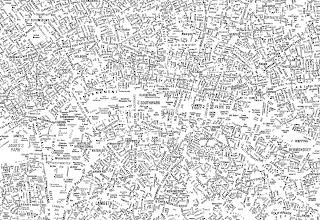This year I have learnt that:
GDF:
- Your first idea is not always your best idea
- I really enjoy working with a sketchbook to clarify and develop my ideas
- Your work is so much more successful if it comes from the research, rather than the other way round
- A graphic design assignment is not so different from writing an essay as I first assumed; both require a thorough amount of research and analysis, to argue the case for a particular outcome
- Two (or three or four…) heads really are better than one when it comes to idea generation
- There is a difference between having conviction in a strong design concept and being precious about it
- Criticism is a GREAT thing! Even if you completely disagree it gives you an insight into how others perceive your work…
- Ideas don't come from a computer
- If 'work' doesn't feel like work, then you're onto a winner!
100 Collages:
- I have a preoccupation with nudity and sex that I was aware of, and a preoccupation with religion, that I wasn't.
GDA: Book Project:
- It's easier tone down an extreme design concept than it is to make a dull design exciting…
- I missed using a sketchbook
- Leaving it until the day before a deadline to check technical/website issues is NOT a good idea
- The gutter is not a good place for crucial (visual) information
- To an extent, it's important to bring a degree of personality to your work, while still fulfilling the needs of the client and the brief.
GDA: Poster Project.
- I was relieved to be reunited with a sketchbook.
- If you can't justify a design decision, you need to really question it's validity: Instinct is a vital ingredient but it is not enough on its own.
- VISUAL ECONOMY IS KEY: For poster design you have such little time to convey your message, that if it's not conveying the message it's too much information.
- If you can't sum up your message in one or two sentences, you either don't know what your message is, or it's too complicated.
- Sometimes your first idea IS your best idea, but you only know that because you've tried everything else…
- The disparity between privileged and deprived around the world is MASSIVE and ultimately simply a result of circumstance: If you can use your skills as a graphic communicator to raise awareness of this disparity YOU SHOULD!
- Print is my passion.
Major Project:
- Sometimes too much planning stifles creativity and your work is more interesting if you don't start out with a destination in mind.
- Sketchbooks smaller than A4 are too small
- If you have multiple projects on the go simultaneously you need to be ORGANISED!
VCT:
- Modernism and early graphic design was reacting against a set of accepted aesthetic principles, and it's not until you know what those principles are that you really understand the rationale behind the success of the work of Modern typographers and designers.
- Sometimes typography needs to be the crystal goblet and sometimes it needs to be more expressive.
PPD:
- Keeping a blog requires discipline!
- A portfolio does not need to be a blow by blow archive of every piece of design you've ever created.
- My true passion lies in print and identity design, and that, although it is a good idea to be familiar with digital developments and software, there will always be a need and a place for well-designed print.
A(n academic) year on, and it really is satisfying to feel like I'm moving forward and improving as a designer. Some of the key things I will take from this year are a conscious scrutiny and justification of my design decisions, staying away from a computer for as long as possible when developing design concepts and visual economy...
Roll on Year 2!





























































